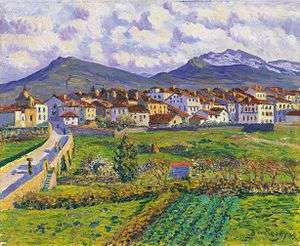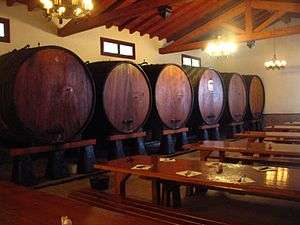Hernani, Gipuzkoa
| Hernani | ||
|---|---|---|
| Municipality | ||
|
Hernani | ||
| ||
 Hernani Location in Spain | ||
| Coordinates: 43°15′58″N 1°58′30″W / 43.26611°N 1.97500°W | ||
| Country |
| |
| Autonomous Community |
| |
| Province | Gipuzkoa | |
| Comarca | Donostialdea | |
| Government | ||
| • Mayor | Luis Intxauspe Arozena (Bildu) | |
| Area | ||
| • Total | 40 km2 (20 sq mi) | |
| Elevation(AMSL) | 44 m (144 ft) | |
| Population (2012) | ||
| • Total | 19,284 | |
| • Density | 480/km2 (1,200/sq mi) | |
| Time zone | CET (UTC+1) | |
| • Summer (DST) | CEST (GMT +2) (UTC+2) | |
| Postal code | 20120 | |
| Area code(s) | +34 (Spain) + 943 (Gipuzkoa) | |
| Website | www.hernani.net | |
Hernani is a town and municipality located in the province of Gipuzkoa, Basque Country, Spain. The town sits on the left bank of the Urumea river.It is located at a distance of 9.2 km from San Sebastian. The municipality of Hernani occupies an area of approximately 40 square kilometers and is bordered by San Sebastián, Astigarraga, Arano, Elduayen, Renteria, Lasarte-Oria and Urnieta.
From the town center, at the foot of Mount Santa Barbara, it is possible to see a large area of the valley of Urumea. Its festivities, held between 23 and June 27 in honor of John the Baptist; and between his celebrations it is to emphasize the popular "Azeridantza"[1] (also celebrated in celebrations of Carnival).
The title character of Victor Hugo's play Hernani is named after the town.
History

During the Middle Ages, the territory that would form the Gipuzkoa Province was divided in valleys and Hernani was one of them. The valley of Hernani formerly extended by all the space between the lower courses of the rivers Urumea and Oria territory.
The first written mentions referred the valley of Hernani go back to a document of a few votes of the Castilian count Fernán González of Castile in favor of Monasteries of San Millan de la Cogolla that are dated to the year 938, but which are believed to be a fake the thirteenth century. Dated to the late twelfth century the donation document of the Monastery of San Sebastián to Monastery of Leyre in Navarre by the king Sancho VI of Navarre, which states that the monastery of San Sebastián was in the borders of Hernani.
When this Navarrese king I create the town of San Sebastián towards 1180, the territory of the valley of Hernani was included within the jurisdiction of the new town.
It is not known when it was created to turn the town of Hernani and populates his letter was lost along with your files on a fire. Some estimate that the foundation of the village occurred during the reign of the king Alfonso X of Castile, in the second half of the thirteenth century, since this king I create a network of strategic towns along the routes linking the coast with Guipúzcoa inside and Hernani could be one of these strategic localities. Others delay foundation of the town until the late fourteenth century later date established as 1379, as a document of the fifteenth century mentions an agreement between the councils of Hernani and San Sebastián for the use of the mountains of the valley of Urumea that took place in 1379, which gives entendar that by that time was already established in Hernani town.
The town of Hernani extended its jurisdiction only on part of the old valley. He lost all the coastal and lower valley of Urumea that continued consisting of San Sebastián strip; and the western area in the valley of the Oria, which became the town of Usúrbil in 1371. Its western limit continued being the Oria river, but in contrast its Eastern limit not marked and the Urumea river as long ago but the mountains separating the valley of the Urumea of those of Oyarzun, the town extending along the right bank of the river. It is believed that the site of the town of Hernani, in an attic to 42 meters high that dominates the left bank of the River Urumea and in turn located at the foot of Mount Santa Barbara, to the location of the primitive main town corresponded valley. This old town, oval, was surrounded by walls and owned several entrances (of which only survives one in the street Felipe Sagarna "Zapa"). Originally owned two streets along (the Street Major-Kale Nagusia and Kardaberaz Street), which were crossed by a street perpendicular (Nafar streets and its prolongation Felipe Sagarna "Zapa").
The first municipal ordinances are of 1542, copy of the ordinances of 1512 disappeared during an invasion of the French army. There are numerous invasions and destruction suffered by the town throughout its history: the medieval factional wars, French invasions in the seventeenth, eighteenth and nineteenth centuries; as well as the hard sieges during the Carlist Wars and finally Spanish Civil War of 1936.
In 1986 came the disengagement of Lasarte, a historical district of Hernani located in the valley of the Oria, that had grown to turn into a village.
Culture
Language

The town lies on a traditionally Basque-speaking area, with the municipality showing a Basque-Spanish bilingual landscape.
Leisure
Hernani is one of the towns with more tradition in the artisan production of Basque cider. Together with Astigarraga and Usúrbil it is one of the areas where most of the Guipuzcoan cider houses (called sagardoteguis) are concentrated. There are many of these establishments in the city. During cider season (February to May) the locality welcomes numerous visitors who come from Gipuzkoa and neighboring provinces to the cider houses. The bars of the old town of Hernani usually have a special animation during the weekends this time thanks to these visitors.
Celebration
The festivities are held at the end of June, coinciding with the feast of St. John the Baptist (June 24). It is traditional that the days 24, 25 and 26 June, coinciding with the celebrations, is dance the previously called Maskuri-danza (dance of the bladder) or Azeri-danza (dance of the fox), a traditional dance, and now mostly known by the latter name because in the 80s of the twentieth century, a character with a mask made of a fox who accompanied him was added. The neighborhoods of Hernani also celebrate their own festivals: Elizatxo Santa Cruz, Ereñozu San Antonio, Santa Barbara San Ignacio, El Puerto, the matyrdom of John the Baptist and Zikuñaga the Virgin of Zikuñaga.
Monuments
The town of Hernani, formerly walled, is cataloged as Monumental Ensemble. Inside the medieval layout of the streets and some buildings of interest it is preserved.
- Religious monuments
- Parochial Church of San Juan Bautista.
- Convent of San Agustin.
- Igoin-Akola Dolmen.
- Cromlechs.
- Civil monuments
- Town Hall.
- Fort of Santa Barbara.
- Tower-house of the Gentiles (or Portalondo).
- Laundry and public source of Leoka.
- Gateway to the village in the canton of Zapa.
Museums
In the town of Hernani is the Chillida-Leku museum devoted to the work of sculptor Eduardo Chillida, natural of San Sebastian.
Demography
From the 1960s, there was a great increase in population, due mainly to the influx of workers from other regions of Spain (Castilla y Leon, Andalusia and Extremadura, mainly), attracted by work in the industry area. This growth paused by the crisis in the industry and the political situation in the late 70s and early 80s.
In 1986 came the disengagement of the district of Lasarte, which became part of a newly created town called Lasarte-Oria. That disengagement represented a loss of about 10,000 inhabitants in Hernani. In the last 20 years the population has remained fairly stable.

Economy
According to the Eustat there are 8722 jobs in the municipality (data as of 1-1-2010), equivalent to 45% of the total population of Hernani. The industrial sector comprises about 45% of the 240 jobs with industrial work centers registered in the municipality.
The population works primarily in the service sector, which employs 62% of the population, the industry employs 26% and the construction workers 10%. Only 1% is currently engaged in farming. (Data 2001). In 2005 the unemployment rate was around 9% of the labor force, a higher percentage of the region. The per capita income in Hernani is approximately between 85% and 90% of the average income of Guipuzcoa and the region of San Sebastian.
The services sector covers the needs of a population of 18,000 inhabitants with regard to commerce, hospitality and utilities that are quite covered. Despite its proximity to San Sebastián, Hernani is not a city-dormitory of the capital and most of its population carries out its life and covers its basic needs in the town itself. For certain types of commerce and services more specialized the population usually go to the nearby capital or commercial center of Usurbil.
Hernani is a heavily industrialized city with some 240 industrial companies surveyed located along the banks of the river Urumea (polygons Landare, Ibaiondo, Zikuñaga, Eziago, Ibarluze). Hernani industry is very diversified. The major companies located in Hernani are the cooperative Orona dedicated to the manufacture and installation of elevators, which has more than 800 employees on its payroll and paper company veteran Papelera Guipuzcoana de Zicuñaga located in the district namesake. Among Hernani industry include numerous chemical companies.
The following companies of Hernani surpass the 50 workers according to the Basque Industrial Catalog:
- Arkema Chemistry: making PVC. It belongs to a multinational group
- Tapes Ubis: tapes
- Goiplastik: plastic injection components. It belongs to Gureak Group employs mentally handicapped.
- Jesus Romero and Sons: DC motors and electronic equipment of regulation and management. Repair and maintenance of electrical machinery.
- Krosaki AMR Refractories: the production of refractory materials. It belongs to the Japanese company Krosaki Harima.
- Loire SAFE: machine tools .
- Oiarso (Bexen): medical equipment for single use. It is a cooperative of Mondragon Corporation
- Orona elevators, ramps, walkways, escalators and lifts. It's another Mondragon Cooperative Group.
- Papelera Guipuzcoana de Zicuñaga (Iberpapel Group): paper company.
- Special Profiles Selak (Savera Group): rolling metal profiles
- Society of Packages, Tubes and Cases (SETE): tubular aluminum containers .
Formerly had great importance in the local economy the steel company Pedro Orbegozo founded in the 1950s and came to employ almost 1,500 workers, most of them hernaniarras. The company finally closed in 1992 after a long crisis and its closing caused a strong impact on the local economy. In the place where it was located formerly this company is currently Ibaiondo Polygon.
Media
- Hernani chronicle, the only Basque daily newspaper.
- MOLOTOFF radio, the free radio of Hernani.
Neighbourhoods
|
|
|
|
Notes
- ↑ https://www.youtube.com/watch?v=OVEQCpXgTYY&feature=related Vídeo del Baile de la Azeri-Dantza o Maskuridantza San Juan 2009 (YouTube)
External links
- Official Website (Spanish) and Basque.
- HERNANI in the Bernardo Estornés Lasa - Auñamendi Encyclopedia (Euskomedia Fundazioa) Basque, (Spanish), (French) and (English).
Coordinates: 43°16′N 1°58′W / 43.267°N 1.967°W

